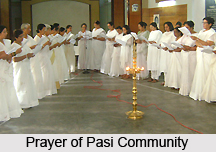 Pasi is a Dravidian occupational caste mainly found in the northern region of the country. Their hereditary employment is tapping of date, Palmyra palm tree and other palm trees for their juice. They are mostly distributed over Bihar, Delhi, Uttar Pradesh and Haryana. A small number of Pasi are distributed over the Terai region of Nepal. Pasis are also called as Paswan and they are scheduled caste. Their name has been derived from Sanskrit term Pashika, which means `one who uses noose`. Interestingly, when Pasis first entered Gujarat, they took to the job of tapping palm trees. This occupation is still followed by the Pasi people.
Pasi is a Dravidian occupational caste mainly found in the northern region of the country. Their hereditary employment is tapping of date, Palmyra palm tree and other palm trees for their juice. They are mostly distributed over Bihar, Delhi, Uttar Pradesh and Haryana. A small number of Pasi are distributed over the Terai region of Nepal. Pasis are also called as Paswan and they are scheduled caste. Their name has been derived from Sanskrit term Pashika, which means `one who uses noose`. Interestingly, when Pasis first entered Gujarat, they took to the job of tapping palm trees. This occupation is still followed by the Pasi people.
Origin of Pasi Race
Pasis claim their ancestry from Bhrigu, a Vedic sage and the creator of the Bhargavas. Further, there are several legends associated with their origin. The Pasi community also traces their origin from Parashuram, incarnation of Vishnu. One of the legends says that once a man was about to kill a number of cows and at the same time Parashuram was practicing austerities in the forest. On hearing the howls of the sacred animals, he reached the place for their rescue. As the cow killer was accompanied by his friends, Parashuram created 5 men out of kusha grass and made them alive by letting his sweat drops fall on them. Thus they were named as Pasi which comes from the Hindi word Pasina which means sweat.
Composition of Pasi Community
 The composition of the Pasi caste is considered of a mixed nature. Like the other migratory castes, Pasis are also split into small numbers and their composition is not very definite. In the central province of the country, their principal sub-castes are the Rajpasis, Kaithwas or Kaithmas, Trisulia, Chiriyamar, Khatik, Hujar, Mangta and Ghudchadha. They have several exogamous clans namely Jamdagni, Parswa, Amlak, Bhargav, and Piplak.
The composition of the Pasi caste is considered of a mixed nature. Like the other migratory castes, Pasis are also split into small numbers and their composition is not very definite. In the central province of the country, their principal sub-castes are the Rajpasis, Kaithwas or Kaithmas, Trisulia, Chiriyamar, Khatik, Hujar, Mangta and Ghudchadha. They have several exogamous clans namely Jamdagni, Parswa, Amlak, Bhargav, and Piplak.
Society of Pasi Community
Pasis generally avoid marriage with blood relations. In their society, widow marriage and divorce are freely allowed. They either burn or bury the dead and funeral rites are followed. Generally, for a man mourning for ten days are observed and for a woman nine days are observed. Pasi people are very religious and they worship all the Hindu deities. Brahmins generally perform marriage and other auspicious ceremonies. Pasi community has a caste council that mainly deals with divorces and other criminal offences like disregard of any traditional social norm. Pasi community is mainly a Hindu community. Apart from their traditional occupation of extraction of juices of palm trees, some of them also go for hunting. Like the Pardhi tribes, Pasis also mend grindstones and are engaged in agricultural activities. In some of the villages Pasis are commonly employed as watchmen in return for which they receive either a plot of land or some other consideration. Pasis were the earliest residents of the Awadh region.





















